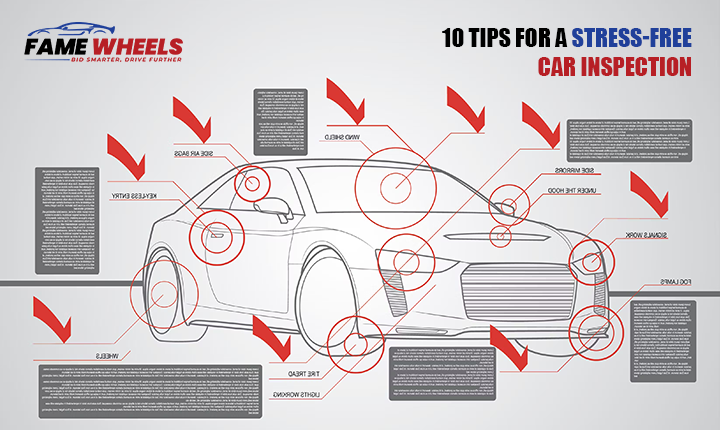Are you purchasing a car? But, you must be stressed out, which car is better and how will you know this one is better for what you are looking for. Purchasing a car is not an easy task, and with insufficient knowledge, you will indeed get framed. Before buying a car, car inspection karachi of Famewheels to check the potential issues and ensure a reliable and safe vehicle. it is very compulsory to understand if the car is perfectly okay to become your life partner. The car inspection karachi shows minor issues that, once addressed, significantly improved the overall performance and safety of the vehicle.The professional car inspection service examined the vehicle, provided a detailed report on its condition, and empowered the buyer with valuable insights for a confident purchase. In this blog, we will review all the different tips and tricks to inspect a car and how you will easily buy one after reading it.
1. Review the paperwork
There are some rules for inspecting the car before purchasing the car. These are:
- Before delving deeper into the inspection process, make sure the car matches the advertisement’s information and the accompanying paperwork.
- It is very important to verify the vehicle’s legal owner registration code.
- Liens are defined as the authority to hold onto the property that belongs to someone else until their debt is settled. It is important to verify these restrictions before purchasing a car.
- Using the VIN, obtain a vehicle history report to look up any accidents, title problems, or odometer inconsistencies.
2. Research Inspection Requirement
Understanding the specific criteria and regulations set by local authorities or inspection agencies for your vehicle is required when researching inspection requirements. Examine the documentation, emission standards, safety regulations, and special requirements. These requirements may differ by region, so check with your local DMV (Department of Motor Vehicle) or relevant authorities to ensure compliance. Use the inspection checklist to address any issues before the inspection to ensure a smooth and successful process.
3. Check the exterior of the vehicle
Examining the exterior helps you identify the overall condition of the car. Make sure to look for weak points for better assessments. These are:
- Examine the windshield for any indications of chips or cracks.
- Inspect the driver’s and passenger’s side lock and unlock mechanism.
- Make sure the lights are working properly.
- Check that warning signals are operating as intended.
- Verify the doors’ alignment and functionality.
- Check the entire body for any scratches, dents, or markings. Make sure the paint is original, or if it has been altered, when and to what quality?
4. Evaluation of Engine as a Necessary Component
A car’s engine is its heart. Any problems that go unnoticed or unsolved could result in a number of problems. Make sure to check the engine’s performance before purchasing a car.
- Start the engine and listen for strange noises, smells, vibrations, or gas exhaustion. Check for oil or fluid leaks under the car and record the level there.
- It is not necessary to examine every component of the engine. Instead, pay attention to the oil level and any indications of leaks. Additionally, check the oil filter.
- As was already mentioned, various odors can indicate a number of engine issues. Visual evaluation of the engine may reveal incorrect moments.
5. Examine the battery
A battery is an electrical energy source that can be recharged. It is made up of lithium-ion or lead-acid cells and transforms chemical energy into electrical power, which powers accessories and starts the engine.A quick visual inspection can be used to determine the battery’s condition with ease.
6. Brake Inspection
It is essential to inspect the brake system to guarantee safe driving conditions. During a brake inspection, the brake pedal, brake liquid, brake pipes and hoses, and brake assemblies are all examined as part of the entire brake procedure.Brake inspections are essential for the security of your car. Examine the brake pedals for any unusual vibrations or odors that could indicate a problem. A burning odor may indicate overheating, and vibrations may indicate warped rotors. Look for evidence of wear and tear on the brake discs and pads. Verify the brake fluid’s condition and level.
7. Addressing Minor Issues
Minor repairs entail repairing minor flaws or damages in your vehicle before they become more serious. This forward-thinking approach ensures that the car is in good working order and reduces the possibility of more serious problems developing. These minor issues include things like replacing burned-out bulbs, repairing minor dents and scratches, and repairing minor leaks. By paying attention to these details, you can ensure that your car stays in good condition, runs smoothly, and avoids more serious and costly problems down the road.
8. Examine the seat belts
Your seat belts must be in good working order. Seat belts are the most important safety measure a driver can take in order to survive a car accident. Check to see if the seat belts can be properly locked and gripped.
9. Clutch Examination
Check that the clutch engages and disengages properly. Keep your foot on the gas pedal and shift the vehicle into gear while running. The gears should shift smoothly, with no popping or grinding. Check the fluid level in a hydraulic clutch and the cables in a cable clutch. The clutch should not slip while in use, and there should be no burning smell or grinding noise.
10. Inspection of Suspension and Steering
Pay attention to any signs of potential problems when inspecting your suspension and steering. If your car dips, squats, rolls, or moves side to side while driving, this could indicate a problem. If your vehicle bottoms out over bumps, bounces excessively or has a rough ride, it may have suspension problems.If the wheels veer unexpectedly when hitting a bump, this could indicate a problem with the steering. Being aware of these warning signs allows you to identify and address potential suspension and steering issues, resulting in a smoother and safer driving experience.
Conclusion
A stress-free automobile inspection includes reading paperwork, studying standards, and inspecting the exterior, engine, battery, and brakes, as well as fixing minor faults. Car inspection Karachi provides peace of mind to the buyer, assuring them of the vehicle’s reliability and safety before making the purchase. It is critical to inspect the seat belts, clutch, tires, warning lights, suspension, and steering. When purchasing a car, gathering paperwork and following these steps allows you to make an informed selection while ensuring safety and performance.








